
 |
|
#76
|
|||
|
|||
|
Hi Mischief,
Share your files as last time. Don't forget to send test files for fine tuning. If you do stereo recording, you don't need to tap anymore. I have programmed an automatic phase alignement routine. I am working on a standalone program so that Doug and yourself can do most of the fine tuning yourself. (simple/multiband tail cut, Equing, Blending... ) Then I'll be able to focus on more exotic l'agorithms based on your feedback. The battle is in the midrange. In this area, there is as much signal as noise... saddly. I've tried many thing with various results (as you've heard). * But I think I will try again the image processing algorithm, I've read it's also used in Reverb deconvolution... Can't be that bad. The main problem is that when you are capturing a room reverb or an amp (ex: Kemper) you control the signal you are sending (Sine sweep, maximul length sequence : MLS...), in my case I don't have access to that ...since the player plays what he wants. So a possibility is to start by making a strong analysis of the pickup track... I did some signal processing trials but not pitch detection. Pitch detection would enable me to locate the harmonics of the note played in the midrange. At those frequencies the signal is better than noise. Then I could make the IR based on those frequencies instead of the whole midrange. It's called regularisation. * The m-parameter algorithm is based on averaging. It's also something they do in reverb capture. They send many time the sine sweep or MLS signal and measure the echo. Since the noise is random, it's always different. Sometimes it is positive, sometimes it is negative. As you average the IR in the spectral domain, the noise is attenuated because positive and negative noises compensate each other. Of course, I did not ask Doug to play many time the same thing... so the m-parameter uses different tricks. But the idea is there. It's probably what Tone Dexter uses. As soon as I'm finished with the standalone app (it could take few days because of the graphic interface), I will try to improve those algorithms. Doug cheered me up by writting me that "bad mic" sound is still better that "good pickup". If I can get to "not to bad mic", I'll stop. PS: Don't be too happy about the standalone program, the more I work on it, the more I think it's going to be impossible to handle for people with no signal processing skills. Simple tail cut and EQ includes already 15 parameters to set. If you add Multiband Tail cut and Resonance cleaning, you can easily multiply by two... Well my wife actually thinks nobody is going to be able to use it. (For that, Tonedexter did a great job, but I have no idea about how close to the mic sound they get). Automating difficulty really depends on the quality expectation of the end user. You don't need fine tuning to get the "wow" factor when you are starting from a piezo undersaddle transducer... It's much harder to get it when you have the amulet, one of the best preamp of the market, audio interface and studio microphones. I wonder for example what kind of preamp and A/D converter are included onboard the Tonedexter. They did not even want to reveal the IR length... I doubt they tell anything.
__________________
Martin 00-18V Goldplus + internal mic (2003) Martin OM-28V + HFN + internal mic (1999) Eastman E6OM (2019) Trance Audio Amulet Yamaha FGX-412 (1998) Gibson Les Paul Standard 1958 Reissue (2013) Fender Stratocaster American Vintage 1954 (2014) http://acousticir.free.fr/ |
|
#77
|
|||
|
|||
|
Hi here is the standalone app (working on Mac OSX)
It does basic IR post-processing. You can load from onboard raw IRs or an external file. On the bottom right you have everyting to load a pickup test recording and compare to a mic recording. 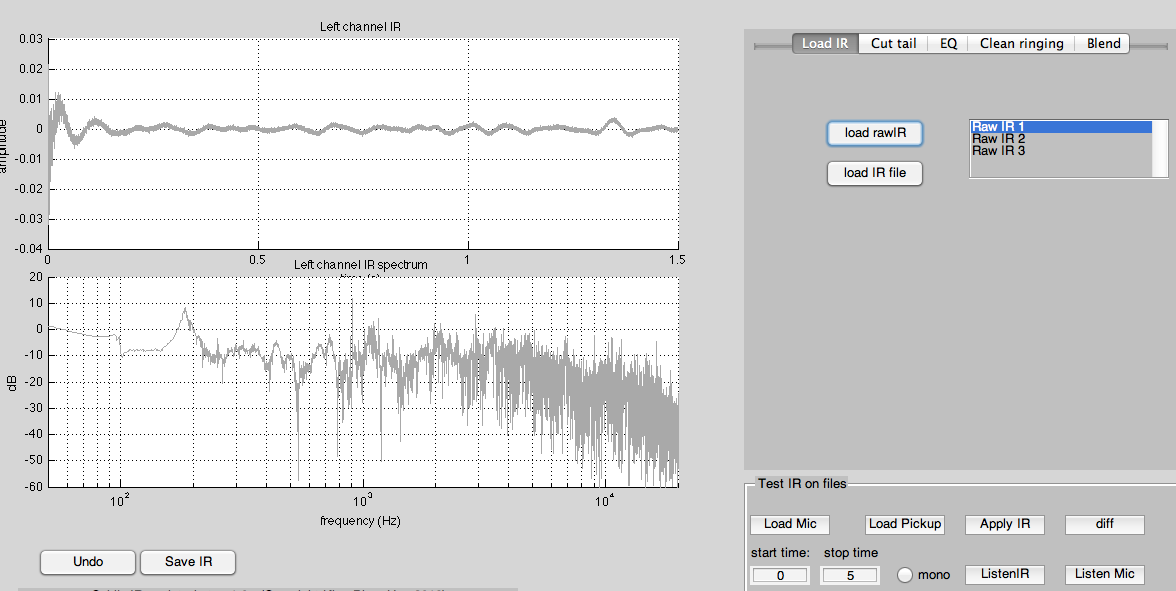 You have simple cut (as in Logic Space designer) and multiband cut 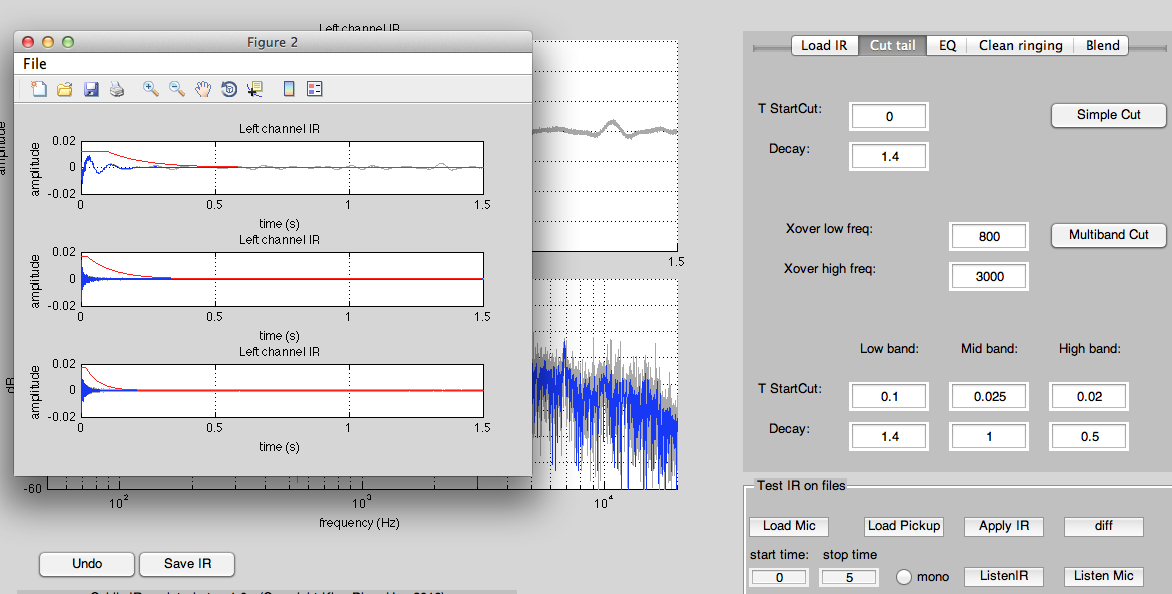 So you can set the note lengths for 3 frequency bands that you can set. On this example, the highs and mids are cut shorter than the lows to magnifies a dreadnough rumble for example. You have parametric EQ with 3 full parametric and 2 shelf filters (low and high) 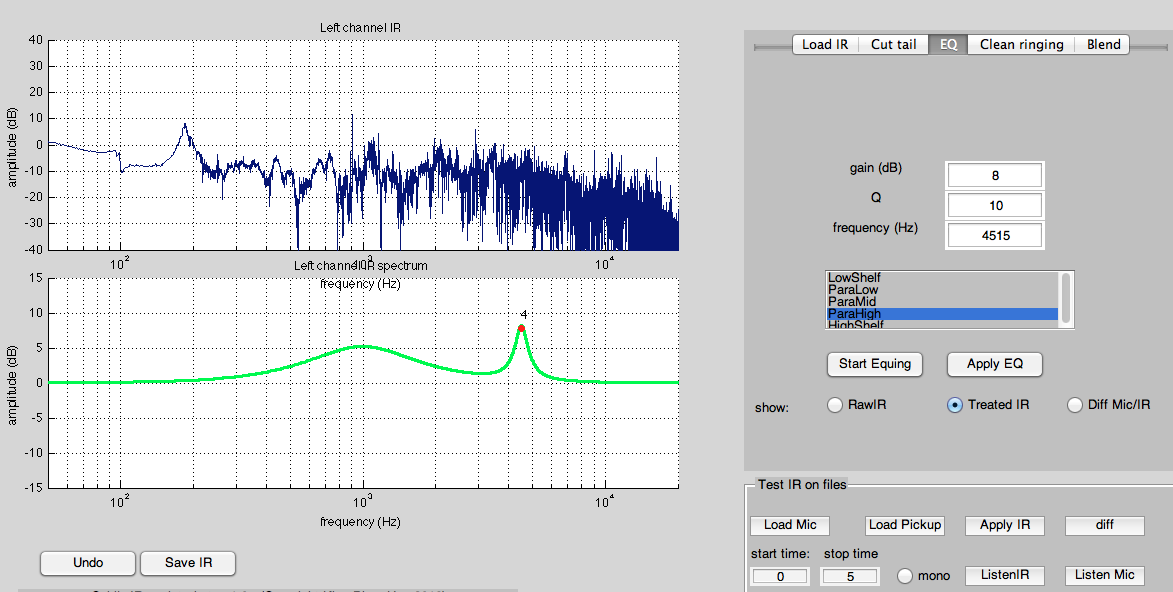 There 's also a "diff" button to automatically generate the difference between a test IR treated pickup and a mic track (If you have spotted a note that does not sound good for example). Then you can adjust your parametric EQ to compensate for that difference. You have a "clean" tab, to notch out the ringing artifacts. You just click on the offending peak and the computer adjust the frequency of the filter. 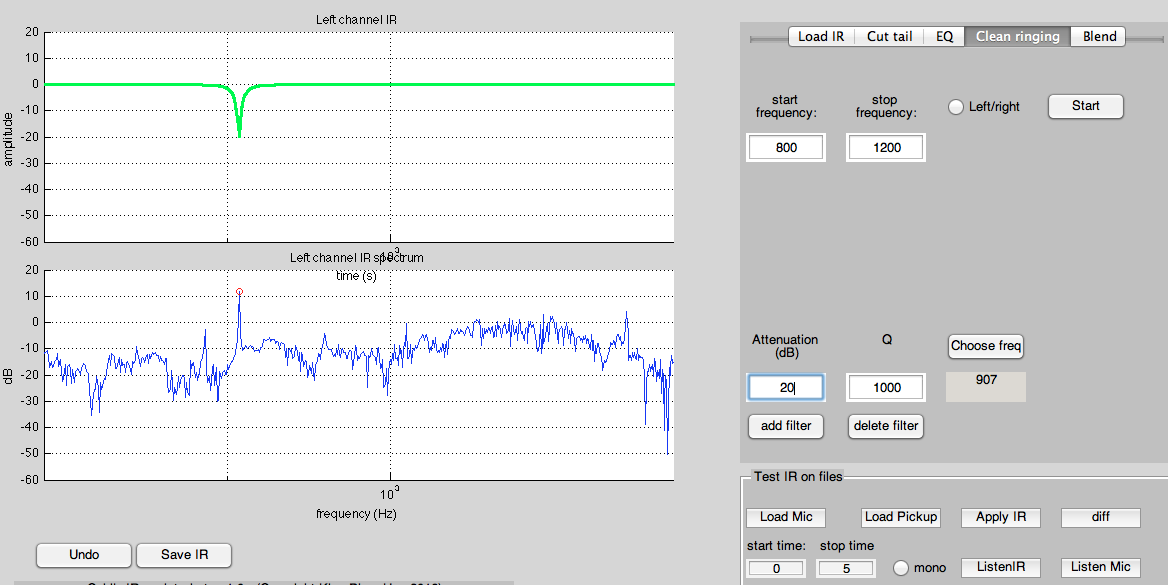 Finally you have a blend tab, with advanced blending (that's new). 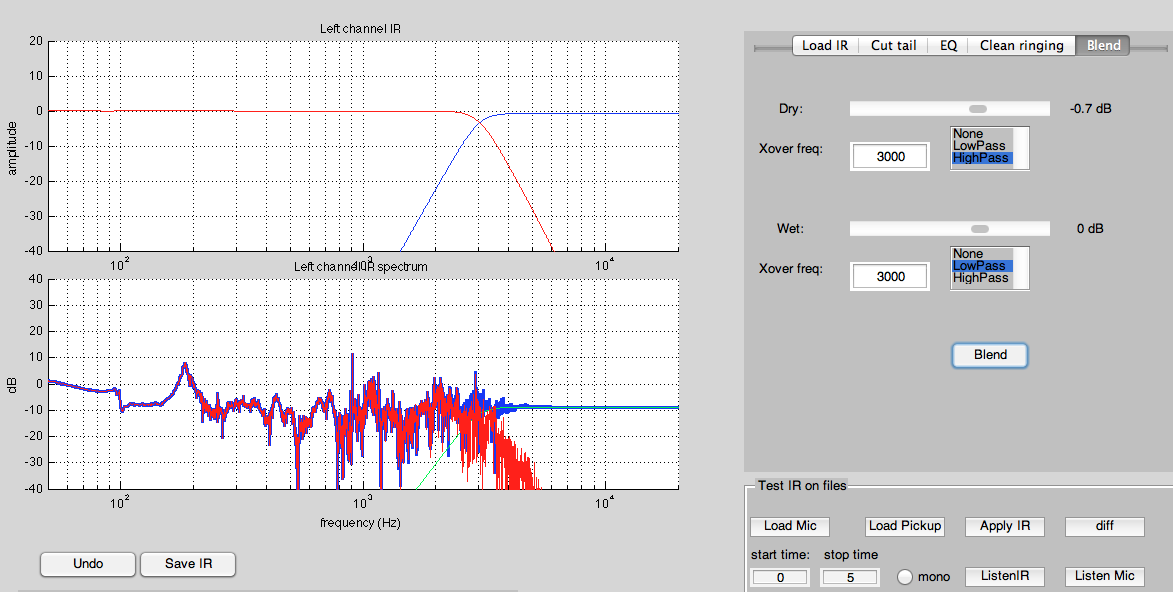 You can blend the dry signal just like the Fishman Aura does. You can also use adjustable crossover filters to use the IR and the dry pickup as a dual source. The IR could handle the lows and the dry pickup the highs. You can also just blend a frequency part of the signal (low or highs). I think I'll stop there since only Maury and Mischief are still folowing the thread. My wife can't stand me working all nights on this anyway. Maury if you want a/few personal IR(s) just send me a PM and I will explain you what recordings I need. I still have to correct few screen bugs and I'll send the program to Doug. Mischief, when you'll send me your recordings, I'll give you the program too so you can adjust your IRs yourself. I want to thank everyone for following that journey. Cuki PS: Maury if you use MS Windows, it should not be to complicated to compile the program for it. Actually it's the first time I've done it on a mac but I've done it before for Windows. PS2: The app does not do advanced IR processing based on averaging or regularization.
__________________
Martin 00-18V Goldplus + internal mic (2003) Martin OM-28V + HFN + internal mic (1999) Eastman E6OM (2019) Trance Audio Amulet Yamaha FGX-412 (1998) Gibson Les Paul Standard 1958 Reissue (2013) Fender Stratocaster American Vintage 1954 (2014) http://acousticir.free.fr/ |
|
#78
|
|||
|
|||
|
Thanks, Cuki, for your efforts!
__________________
Martin HD-28 Sunburst/Trance M-VT Phantom Martin D-18/UltraTonic Adamas I 2087GT-8 Ovation Custom Legend LX Guild F-212XL STD Huss & Dalton TD-R Taylor 717e Taylor 618e Taylor 614ce Larrivee D-50M/HiFi Larrivee D-40R Blue Grass Special/HiFi Larrivee D-40R Sunburst Larrivee C-03R TE/Trance M-VT Phantom RainSong BI-DR1000N2 Emerald X20 Yamaha FGX5 Republic Duolian/Schatten NR-2 |
|
#79
|
|||
|
|||
|
Just a note to tell you I'm still following the thread, if that helps at all. I still love the results you're getting and I'm sure that what you're doing is improving sound quality and extending what's possible all across the board in live acoustic sound. If I had the money, I'd be backing a product based on your experiments now.
|
|
#80
|
|||
|
|||
|
I would also like to thank Cuki for all his efforts time, insight and determination and of corse results.
I think you have made a significant contribution to this technology. So once again thank you very much. |
|
#81
|
|||
|
|||
|
definitely the 3rd one. 3>>2>>1
Massive difference i'm hearing in the 3, so surprised to read some people say they're close. |
|
#82
|
|||
|
|||
|
Hi everyone,
I thought we should end this thread with music. So I tried another "exotic" process. As I've said before, the challenge is the high and mid-range because the IR gets polluted by noise as the frequency goes higher. It finds explanation in the fact that higher harmonics (with high frequencies) have less and less power whereas the noise is always the same. All the previous IRs suffered from that. For example, the "raw" IR looked like that:  You can see the noise becoming more and more important for frequencies over 1 KHz. So basically all the strategies I used were meant to restore the high end and midrange. That's also what eventually limits us to "bad mic" sound since "bad mic" usually do not capture well the high end. So the last strategy I tried, was a bit like "chess". This time I voluntary sacrificed the low end to put all the effort on the midrange (where our ears actually hears best). This is the result:  In this case, I totally lost resolution on the low end, but in return I've got a much smoother midrange and better signal to noise ratio on the higher end. Morevover, the high frequency roll off is somehow tamed. The raw IR is much more even than before. Note that in the end, it does not prevent us to use both IRs to build our sound. One can use a digital crossover filter to bring the low-end from the older IR and the high-end from the new but it's another story... Here are the samples: Doug's playing. Trance Amulet alone External Microphones Last IR: just simply cut (No EQ, No multi band cut, No resonance notching, No blending... basically raw) Another recording (Still Doug) Trance Amulet alone External Microphones Last IR: just simply cut (No EQ, No multi band cut, No resonance notching, No blending... basically raw) I believe it's an improvement. The other IRs always have a kind of caricatural midrange, this is better. And it sounds better too in mono. One can still EQ a bit to get some brightness and air back with the standalone app (as I did before with the previous IRs). Bye Bye Cuki PS: Doug does not have the time to test it yet. I hope he will like it.
__________________
Martin 00-18V Goldplus + internal mic (2003) Martin OM-28V + HFN + internal mic (1999) Eastman E6OM (2019) Trance Audio Amulet Yamaha FGX-412 (1998) Gibson Les Paul Standard 1958 Reissue (2013) Fender Stratocaster American Vintage 1954 (2014) http://acousticir.free.fr/ |
|
#83
|
|||
|
|||
|
Sorry I know I've said I'd stop... But I have finally a good match!
It's the same IR with a 6.8dB boost over 1KHz done by blending the pickup signal through a high pass filter with the standalone app. Trance Amulet alone External Microphones IR: simply cut +high shelf Boost 6.8dB over 1 KHz Another recording (Still Doug) Trance Amulet alone External Microphones IR: simply cut +high shelf Boost 6.8dB over 1 KHz I think I've nailed it  Cuki
__________________
Martin 00-18V Goldplus + internal mic (2003) Martin OM-28V + HFN + internal mic (1999) Eastman E6OM (2019) Trance Audio Amulet Yamaha FGX-412 (1998) Gibson Les Paul Standard 1958 Reissue (2013) Fender Stratocaster American Vintage 1954 (2014) http://acousticir.free.fr/ |
|
#84
|
|||
|
|||
|
I think you've nailed it too! Nice work and Thanks!
I'll try and get a recording to you soon.
__________________
Martin HD-28 Sunburst/Trance M-VT Phantom Martin D-18/UltraTonic Adamas I 2087GT-8 Ovation Custom Legend LX Guild F-212XL STD Huss & Dalton TD-R Taylor 717e Taylor 618e Taylor 614ce Larrivee D-50M/HiFi Larrivee D-40R Blue Grass Special/HiFi Larrivee D-40R Sunburst Larrivee C-03R TE/Trance M-VT Phantom RainSong BI-DR1000N2 Emerald X20 Yamaha FGX5 Republic Duolian/Schatten NR-2 |
|
#85
|
|||
|
|||
|
Hi everyone,
I added a new feature. Is some of you knows our ears don't work the same with respect to loudness. 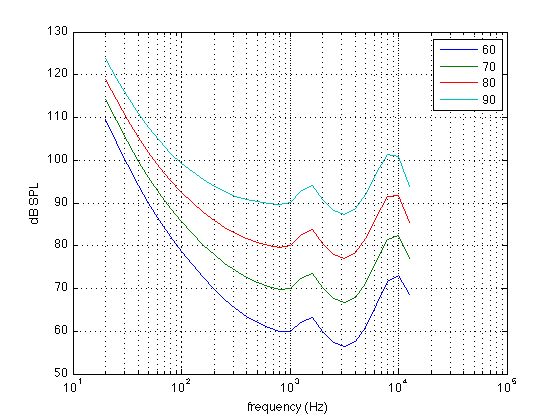 The Fletcher and Munson curves tell us that we are nearly deaf for low frequencies and very sensitive to baby voice frequencies. If one subtracts the 60 phons (blue) and 90 phons (light blue) curves, you get what correction has to be made going from quiet to loud sounds. Most of us know that when you push the volume the sound becomes mid heavy. That's why on every Fishman amp/preamp manual they recommend to tame the mids when playing loud. From the Fletcher and Muson curves (ISO226) you can compute the exact correction (in red) and compute a digital filter that approximates this (blue) 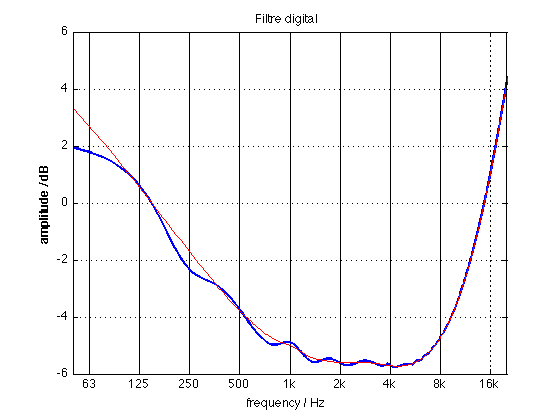 Of course you can also lower your mid control and push up the lows and high (as suggested in Fishman manual) but I though it would be cool to have that included in my pedal. Cuki
__________________
Martin 00-18V Goldplus + internal mic (2003) Martin OM-28V + HFN + internal mic (1999) Eastman E6OM (2019) Trance Audio Amulet Yamaha FGX-412 (1998) Gibson Les Paul Standard 1958 Reissue (2013) Fender Stratocaster American Vintage 1954 (2014) http://acousticir.free.fr/ |
|
#86
|
|||
|
|||
|
Cuki that's super cool.
Love what your doing and your getting awesome results. I still find this completely fascinating. Thanks for your contributions. |
|
#87
|
|||
|
|||
|
Hi everyone,
this is my take on the Tonedexter character's button 1) DPA mic 4099 2) Lyric alone 3) Old IR same process that for Doug without fine adjustement (usually I blend a few dB of original signal over 2-3kHz and tame the low with a parametric EQ). Here it's raw: so very woofy-dark almost as a Fishman Aura image. 4) Very simple process + Minimum phase process as indicated in the Tonedexter. The IR is manually cuted with Audacity very short so I may have cut a too much low end. I've used old recordings to train the IR so, the DPA mic could be placed differently. I think the comparison with the DPA speaks for itself. I am a huge fan!
__________________
Martin 00-18V Goldplus + internal mic (2003) Martin OM-28V + HFN + internal mic (1999) Eastman E6OM (2019) Trance Audio Amulet Yamaha FGX-412 (1998) Gibson Les Paul Standard 1958 Reissue (2013) Fender Stratocaster American Vintage 1954 (2014) http://acousticir.free.fr/ |
|
#88
|
|||
|
|||
|
That last file is excellent. I think I like it better than the DPA alone. It's not as natural sounding in the decaying artifacts of the guitars sound (what you might think of as woodiness) but as a work-a-day pickup profile, it's excellent.
Last edited by dannyg1; 04-26-2017 at 02:07 PM. |
|
#89
|
|||
|
|||
|
Really cool stuff. I 1/2 way understand it.
Is there a 'goal' to a this? Beyond just experimenting? Some product or procedure that others could use? Sent from my iPhone using Tapatalk
__________________
'10 Wechter 5712c - Fishman Rare Earth '13 Jaffrey #26 - Malaysian Blackwood! '21 Gretsch 5622 '22 Furch Red Pure G-LR - Barbera Soloist ST-300 Mini + DIY mic preamp |
|
#90
|
||||
|
||||
|
Not sure what Cuki's goal was, mine was just interest. You could load his images into a IR pedal like Logidy, so there's some potential for a "product". But at this point, if you're interested in a product you can use, check out the ToneDexter (see the long thread in this topic), which wraps this (or something similar) all up in a box anyone can use without knowing all the math.
__________________
Music: Spotify, Bandcamp Videos: You Tube Channel Books: Hymns for Fingerstyle Guitar (std tuning), Christmas Carols for Fingerstyle Guitar (std tuning), A DADGAD Christmas, Alternate Tunings book Online Course: Alternate Tunings for Fingerstyle Guitar |